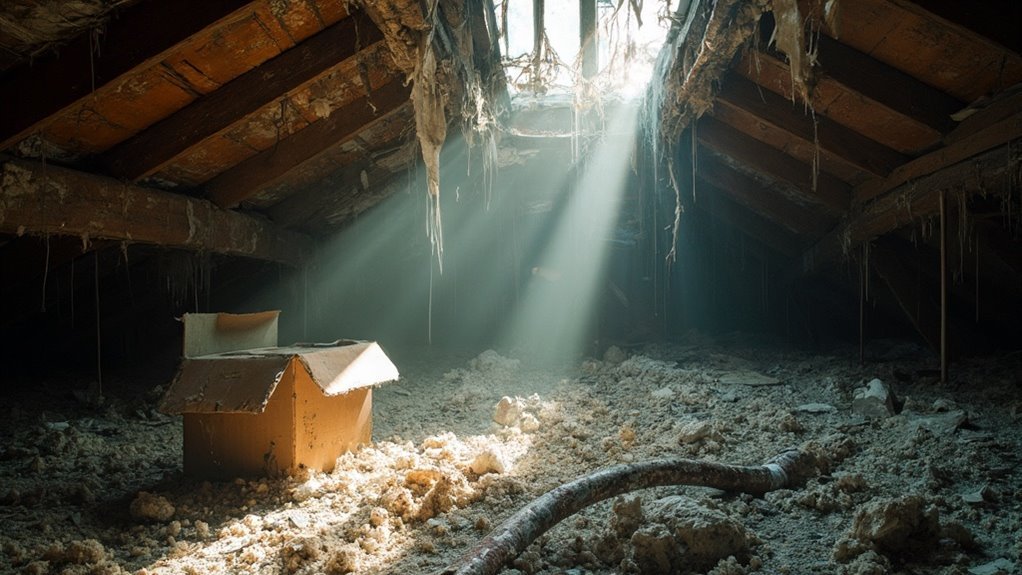Asbestos exposure poses severe health risks, including lung cancer, mesothelioma, and asbestosis, with no safe level of inhalation. Over time, symptoms may emerge, but these can take decades to manifest. Various asbestos types, such as chrysotile and crocidolite, differ in danger yet all are carcinogenic. Disturbing older materials in homes or workplaces can release harmful fibers. Consequently, abatement is critical; it reduces disease risks, improves property value, and guarantees compliance with safety regulations. Employing trained professionals for safe removal is vital. For an all-encompassing understanding of asbestos' impact, continue to investigate the recommended practices and insights.
Understanding Asbestos Health Risks

Recognizing the severe health risks associated with asbestos exposure is fundamental for both individuals and communities. Asbestos exposure can lead to serious diseases such as lung cancer, mesothelioma, and asbestosis. No amount of asbestos is considered safe; the risk of developing these diseases increases with the quantity inhaled. Even small exposures can have devastating consequences, including chronic respiratory issues. Regular testing is essential to identify potential asbestos in older buildings, further emphasizing the need for vigilance.
The latency period for asbestos-related diseases often spans 20 to 50 years, complicating diagnosis and treatment. Initial symptoms can be vague, comprising coughing and shortness of breath, which may delay medical attention. Additionally, combining smoking with asbestos exposure greatly raises the risk of lung cancer. All asbestos fibers are harmful if breathed, making it crucial to treat any potential exposure with utmost seriousness.
Asbestos regulations play a key role in mitigating these health risks. Effective health monitoring and early diagnosis are crucial for those exposed. Establishing registries for individuals with past exposure can improve tracking and treatment efforts. Awareness and education on the dangers of asbestos are similarly important, emphasizing the need for stringent regulations and preventive measures. By taking these actions, communities can protect themselves from the hidden dangers of asbestos exposure and the severe health consequences that follow.
Types of Asbestos and Their Dangers
Asbestos exists in several distinct types, each posing unique dangers to health. Understanding these types is vital for effective asbestos identification techniques and ensuring safe environments. Here's a breakdown of the primary types:
| Type of Asbestos | Appearance | Health Risks |
|---|---|---|
| Chrysotile | White, long, curly fibers | Lower risk compared to others, yet still hazardous |
| Amosite | Brown, straight, needle-like fibers | Higher mesothelioma risk because of longer lung retention |
| Crocidolite | Blue, short, sharp fibers | Extremely dangerous, associated with severe lung diseases |
Chrysotile, while accounting for 90-95% of U.S. asbestos use, is less harmful than amphibole types like amosite and crocidolite. Nevertheless, all types are hazardous, with no safe exposure level. Comparative fiber analysis shows that amphibole fibers remain in the lungs longer, heightening the risk of asbestosis, lung cancer, and mesothelioma. Regular inspections reveal potential asbestos sources, essential for maintaining a safe living environment. Remember, even minor disturbances can release airborne fibers, increasing inhalation risks. Recognizing the different types and their dangers is fundamental in taking the necessary steps for abatement and protection against exposure.
Common Sources of Exposure

Exposure to asbestos remains a significant health concern across various environments and industries. Understanding common sources of exposure is essential for mitigating occupational hazards and environmental risks. Here are some key areas where you might encounter asbestos:
- Occupational Settings: Workers in construction, shipbuilding, and manufacturing face high exposure risks because of asbestos-containing materials.
- Older Homes: Homes built before the 1980s often contain asbestos in insulation, tiles, and pipes, putting residents at risk during renovations.
- Natural Environments: Gardening or playing in areas with naturally occurring asbestos can lead to inhalation of hazardous fibers.
- Recreational Activities: Hobbies involving old materials, like auto repairs or DIY projects, may disturb asbestos, resulting in exposure.
Being aware of these sources is essential for protecting yourself and others. If you work in or frequent these environments, take precautions to minimize your risk. Regular monitoring and professional evaluations can help identify asbestos presence, ensuring you stay safe from the hidden dangers it poses. Remember, understanding these common sources is the first step in safeguarding your health against asbestos exposure.
The Importance of Abatement
Effective asbestos abatement is vital for safeguarding health and guaranteeing safety in both residential and occupational environments. By employing appropriate abatement techniques, you greatly reduce the risk of asbestos-related diseases. The process not only protects the health of occupants and workers but also creates safer living and working environments by eliminating hazardous asbestos fibers.
Here's a breakdown of the key benefits of asbestos abatement:
| Category | Benefits | Impact |
|---|---|---|
| Health & Safety | Reduces disease risk | Healthier environments |
| Financial | Improves property value | Increased marketability |
| Regulatory Compliance | Guarantees adherence to regulations | Avoids legal liabilities |
| Environmental | Promotes responsible disposal practices | Protects the ecosystem |
| Long-term Safety | Prevents future exposure risks | Sustains a healthy environment |
Abatement not only aligns with the regulatory framework but also offers considerable long-term benefits. By investing in professional abatement services, you protect your property and health while complying with necessary regulations, providing peace of mind and a safer future.
Safe Removal Practices

When removing asbestos, proper equipment usage is critical to guarantee safety and compliance. You need to rely on trained professionals who understand the regulations and techniques required for safe abatement. By following established protocols and using the right tools, you greatly reduce the risks associated with asbestos exposure.
Proper Equipment Usage
To guarantee the safe removal of asbestos, it's crucial to utilize proper equipment and adhere to established safety practices. This not only protects you but likewise minimizes the risk of asbestos fiber release into the environment. Regular equipment maintenance and safety inspections are fundamental to confirm everything functions correctly throughout the removal process.
Here are key equipment considerations:
- Physical Barriers: Use plastic sheeting or temporary walls to contain asbestos fibers effectively.
- Negative Air Pressure Systems: Implement HEPA filters to capture airborne asbestos and prevent its spread.
- Wet Removal Methods: Always saturate asbestos-containing materials (ACMs) to limit fiber release.
- Personal Protective Equipment (PPE): Equip workers with respirators, gloves, and coveralls to safeguard against exposure.
Trained Professional Oversight
Trained professionals oversee safe asbestos removal practices, guaranteeing compliance with regulations and minimizing health risks. Their expertise in professional certification is crucial for developing thorough abatement plans, securing permits, and conducting risk assessments. This oversight assures that all procedures meet regulatory compliance, ultimately protecting you and others from asbestos exposure.
| Aspect | Importance | Key Action |
|---|---|---|
| Preparation | Identifies scope and compliance requirements | Develop abatement plans |
| Safe Removal Techniques | Minimizes airborne fiber release | Use wet removal methods |
| Post-Abatement | Confirms air quality and proper disposal | Conduct clearance testing |
Professional abatement services employ controlled dismantling methods and engineering controls to guarantee a safe environment. They utilize wetting agents to suppress fiber release, handle asbestos-containing materials with care, and implement robust decontamination procedures. Moreover, hiring separate asbestos inspectors and contractors helps avoid conflicts of interest, guaranteeing that you receive unbiased assessments and services.
Global Trends in Asbestos Use
As you investigate global trends in asbestos use, you'll find that current statistics reveal significant regional disparities, particularly in consumption. While numerous countries have enacted bans, the health implications of asbestos exposure continue to pose a serious risk worldwide. Understanding these trends is essential for addressing the ongoing challenges related to asbestos management and safety.
Current Usage Statistics
In 2023, global asbestos production is estimated at 1.3 million metric tons, highlighting ongoing use in spite of widespread awareness of its health hazards. This statistic reveals a concerning trend in asbestos production, even as many countries impose regulations. Here are some key points to reflect upon:
- Declining Usage in the U.S.: From 803,000 metric tons in 1973 to just 360 metric tons by 2015, showing a significant drop.
- Major Producers: Russia remains the largest producer, contributing heavily to global asbestos production trends.
- Health Impact: Over 200,000 deaths annually are linked to occupational asbestos exposure, underscoring the urgent need for effective abatement.
- Future Projections: The asbestos market is expected to grow, with a compound annual growth rate projected from 2024 to 2031.
These asbestos import statistics reveal a complex scenario: while some regions are reducing usage, others continue to rely on this hazardous material. Understanding these trends is essential for advocating for safer alternatives and implementing effective regulatory measures.
Regional Bans Overview
In spite of significant reductions in asbestos usage in various regions, the material's persistence in global markets highlights the stark disparity in regulatory approaches. Currently, 55 countries have enacted extensive bans on asbestos, particularly within the European Union, which finalized its ban in 2005. Australia, New Zealand, and Japan similarly maintain strict asbestos regulations, ensuring minimal exposure. Conversely, countries like China and India face considerable enforcement challenges, allowing continued use in light of the known health risks.
North America shows a mixed picture; Canada successfully implemented a ban in 2018, while the United States has limited bans based on specific applications. In South America, Brazil's 2017 ban reflects growing awareness, but enforcement remains inconsistent across the continent.
Enforcement challenges are particularly pronounced in developing nations, where regulatory frameworks may be lacking. The International Ban Asbestos Secretariat champions a global ban, highlighting the need for coordinated regional enforcement. Effective asbestos regulations are essential not only for public health but also for ensuring that the lessons learned from countries with stringent bans are shared and implemented worldwide. Only through collaborative efforts can we hope to eradicate the dangers posed by asbestos.
Health Implications Worldwide
The health implications of asbestos exposure are significant and far-reaching, impacting millions globally. In spite of a considerable decrease in production, with only around 1.3 million metric tons mined in 2023, asbestos continues to pose severe risks. Countries like Russia, Kazakhstan, and China remain major producers, leading to ongoing exposure.
- Over 200,000 deaths occur annually as a result of asbestos-related diseases.
- All asbestos forms are classified as carcinogenic by WHO.
- Long latency periods lead to continued health issues even after exposure.
- Co-exposure to tobacco smoke greatly raises lung cancer risks.
Effective asbestos regulations are vital to mitigate these health risks. Implementing preventive measures, such as banning all forms of asbestos and ensuring worker protection during maintenance and removal, is fundamental. Establishing registries for those exposed and providing ongoing medical surveillance can help track and manage asbestos-related diseases. Raising awareness among medical professionals and labor inspectors is necessary for early diagnosis and treatment. As countries move towards stricter regulations, the need for thorough preventive strategies becomes increasingly urgent to protect public health and prevent further fatalities.
The Economic Impact of Asbestos

Asbestos exposure carries significant economic repercussions that extend far beyond individual health costs. A thorough economic evaluation reveals that annual global healthcare costs associated with asbestos-related health effects range between $2.4 and $3.9 billion. In the U.S. alone, litigation costs related to asbestos are estimated at $2.3 billion each year, highlighting a substantial burden on both individuals and healthcare systems. In addition, premature mortality resulting from asbestos-related diseases leads to economic losses estimated at $3.4 billion annually in the UK.
Indirectly, asbestos-related illnesses lead to productivity losses through absenteeism and decreased work capacity, impacting industries and overall economic growth. The loss of skilled labor due to early mortality further intensifies these effects. While the immediate costs of asbestos removal and replacement can be high, implementing bans on asbestos shows no negative economic impact and can ultimately stimulate growth through decreased healthcare expenses.
Effective cost analysis indicates that strategies like encapsulation can save 15-25% compared to complete removal. Prioritizing high-risk areas for partial removal and securing financing options can additionally help manage abatement costs efficiently, ensuring safety without compromising economic stability.
Raising Public Awareness
Public awareness about the dangers of asbestos is fundamental, especially for those involved in DIY projects or working in trades. To effectively combat asbestos-related health risks, targeted awareness strategies are significant. Here are key points to reflect on:
- Health Risks: Understand that asbestos exposure can lead to serious illnesses like asbestosis and mesothelioma.
- High Exposure Statistics: Know that 1.3 million American workers still encounter asbestos in their jobs, highlighting the need for vigilance.
- Effective Campaigns: Participating in community engagement initiatives can amplify the reach of awareness campaigns, guaranteeing more people are informed.
- Professional Guidance: Always seek the advice of licensed professionals for asbestos testing and potential removal to guarantee safety.
Through video-led campaigns and strategic partnerships, we can educate Australians aged 18-55, particularly DIY enthusiasts and tradespersons, about these hidden dangers. The upcoming phases of the campaign, aligned with popular renovation periods, will further improve community engagement. By sharing campaign materials and promoting these significant messages, you'll play a key role in reducing asbestos exposure and protecting public health. Remember, no level of asbestos exposure is safe, so stay informed and proactive.
Frequently Asked Questions
Can I Test My Home for Asbestos Myself?
While DIY testing might seem like a handy option for home safety, it often lacks the accuracy and expertise needed. You're better off consulting professionals who can guarantee thorough, reliable results and proper safety measures.
What Are the Symptoms of Asbestos-Related Diseases?
Asbestos symptoms often include shortness of breath, persistent cough, and chest pain. As these symptoms progress, you might experience fatigue and weight loss, indicating potential disease progression, such as asbestosis or lung cancer.
How Long Does Asbestos Stay in the Body?
Asbestos exposure can lead to significant health risks, with chrysotile fibers clearing from your lungs in under eight years, while amphibole fibers may persist for many years, increasing the potential for serious health issues.
What Should I Do if I Find Asbestos?
If you find asbestos, immediately contact a certified abatement company for professional inspections. They'll assess the situation, determine the need for asbestos removal, and guarantee compliance with safety regulations throughout the process.
Are There Any Safe Alternatives to Asbestos in Construction?
Asbestos substitutes like cellulose fibre, rock wool, and hemp offer safe, sustainable construction materials. These eco-friendly options provide excellent insulation and durability, ensuring your projects meet safety standards without compromising performance or environmental impact.
